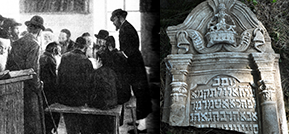A Jewish community first appeared in Nadworna at the end of the seventeenth century (Pinkas Hakehilot, 328).
In the mid-eighteenth century there was at least one member of the Frankist movement, Laib Krysa, living in the town. Krysa took part in the famous disputation between Frankists and Jewish rabbis in Kamenets Podolsk in 1757. After his baptism he changed his name to Dominic Antoni Krisinski (Shmuel Hübner, "Yehudah Leib Krisa," Sefer Nadvurna, 32-3 [Hebrew], 128-30 [English]).
The census of 1764 gives detailed information on the Jewish population of Nadworna (Stampfer, 124-5). The community (kahal) included 1,196 Jews of both genders and 75 infants under the age of one year of age. 937 Jews with a total of 65 infants lived in the town of Nadworna itself and the rest (259) were dispersed among surrounding villages accordingly:
Przerosła - 4 (and one infant)
Mołotków - 3
Hwod - 9 (and two infants)
Łanczyn - 7
Kraśniany - 9 (and one infant)
Maniowa - 12
Krasne - 8
Cucyłów - 13
Nazawirów - 12 (and one infant)
Sadzawa - 6
Osławy - 5
Białosławy - 5
Strymblany - 6
Pniów - 13
Bytków - 6
Zielone - 5
Tekinki - 5
Berezów - 6
Łuczki - 7
Parysce - 6
Czarny Potok - 7
Tarnawica - 9
Pasieczne - 9
Delatyn - 87 (and 5 infants)
The Nadworna community with 1,196 Jews was the largest community in the Kołomyia district (powiat) and belonged to a group of large Galician communities (about 1,000 Jews). Its jurisdiction also spread to the town of Delatyn which had 87 Jews.
After the Austrian annexation of Galicia a school was established in Nadworna in 1785 by the enlightened Jew (maskil) Hertz Homberg as part of a larger educational network under his jurisdiction. Despite government efforts and cooperation with local maskilim it is not clear whether or not the school never opened (Pinkas Hakehilot, 329).
Further reading: Nadworna - Jews in the 19th and the early 20th centuries






